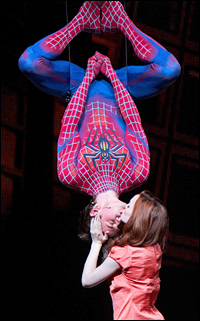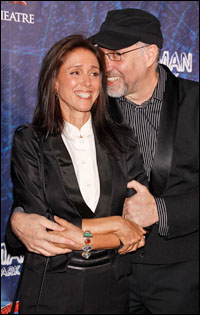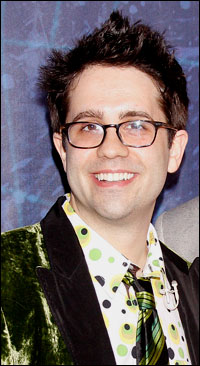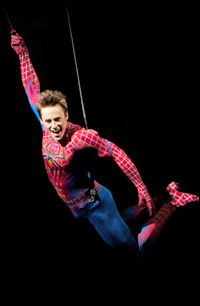
*
In an annals of Broadway history, never have show doctors been confronted with such a conundrum as were director Philip Wm. McKinley, playwright Robert Aguirre-Sacasa and choreographer Chase Brock when they were brought in to fix Spider-Man Turn Off the Dark.
Under the penetrating gaze of the entire theatre community and press, the producers hung a $65 million albatross around the neck of the new collaborators and said, "Make it fly." Even legendary show doctors like George S. Kaufman and Neil "Doc" Simon might have blanched at the assignment. But the trio took on the labor, and shut down the show (now said to have a production cost of $75 million) for a month. They reopened at Foxwoods Theatre on June 14 with a production that the critics had to admit was vastly different than the one put together by original (and, still, official) director Julie Taymor. Playbill.com asked the three men how they did it. Here are their answers.
 |
||
| Philip Wm. McKinley |
||
| photo by Joseph Marzullo/WENN |
When you began work on Spider-Man, how did you view your job? What were you there to do?
PM: I was on a rescue mission. I was there to save a show that had a great deal of potential, but it didn't work for the audience. The company consisting of 140 Broadway artists, designers and technicians had been raked through the public fires of criticism from the journalists, the critics, the bloggers, the chat rooms, etc. Everybody in New York had an opinion about Spider-Man whether they'd seen the show or not. This constant barrage of public attention had in some way demoralized the company. The first time I met the company I could feel the skeptical energy that dominated the room. The cast and crew had dedicated themselves to months of work (in some cases over a year) and yet the show was still not working for the audience. Why should they trust me, a stranger to most of them? A stranger who was telling them they would preview May 12 and open June 14. They'd heard that one before.
My objective became two-fold: 1.) fix the show (mainly the story) so it would appeal to the audience (which consisted of young children to senior citizens); and 2.) restore the confidence of the cast, staff and crew who I knew were some of the most talented and dedicated people to ever step foot on a Broadway stage. If they'd lived through the process so far, I knew they had the dedication and the fortitude to get it home. I said, "I'm going to ask you to do something that is the hardest thing a director can ask; open your hearts once more and trust me." They did.
 |
||
| Reeve Carney and Jennifer Damiano in Spider-Man Turn Off the Dark. |
||
| photo by Jacob Cohl |
PM: Certainly the story was the most affected by the 2.0 remount. I don't think a page of the script has been untouched or hasn't been rewritten in some form. The most difficult aspect of the rewrite was having to do it all within the parameters and the logistics of the physical production. We couldn't cut all the scenery and start from scratch. We had to use what was on the stage and make it work for the new script, which of course is the opposite of how you would normally construct a show.
But the real change to the show was making it appeal to an audience of all ages. "Family entertainment" is a very misunderstood and undervalued form of theatre. And it's a very difficult theatre form because it has to appeal to a six-year-old child and an 86-year-old adult. The story has to be clear and concise or you lose the younger members of your audience. And the story has to have enough action to keep their attention and yet it cannot be too simplistic or the adults lose interest. In some cases you build parts of the show to appeal to children whose reactions are being watched by the supervising adult. What better experience than to take your child to a Broadway show and watch their face light up as theatre magic unfolds before them?
An example would be the "Bonesaw" wrestling match. It has been talked about in many cases as "ridiculous" or "childish." Of course it is. It's meant to be. It's fun...it's a comic book moment. I've watched repeated performances and see how adults love that section because it's an adult actor playing with an adult-size child's blowup toy. The adults enjoy watching their children laugh at that scene and the children love watching their parents laugh as well. If it were two actors beating up each other it would not have the same results. I dare say it would be extremely violent and to what purpose?
The death of Uncle Ben and the funeral on the other hand are very serious and somber adult scenes. Both the adult audience and the younger audience observe both scenes but in different ways and with different sensibilities.
On the other hand, the teenage audience relishes the scenes between Peter Parker and Mary Jane Watson. One journalist noted that the show is: "'Twilight' (the movie) in superhero tights." Exactly! It's a teenage crush that becomes a love affair. The show is ideal for the Wicked audience but it's not just for girls — we're finding the boys are into the action-hero aspects of the show and the "getting the girl" in the final moment.
The decision to balance the adult/child moments is always at hand when you are creating entertainment to appeal to a demographic expanding 80 years of age as well as finding the balance to appeal to the male and female audience. The new Spider Man 2.0 appeals to our audience who span those demographics.
PM: Once the show closed, we had a week of rehearsal in the studio and then we had two-and-a-half weeks in the theatre to tech the show before previews. A typical day was 15 to 18 hours. It started around 6:30 AM answering emails from the night before. Questions from the stage mangers, design team or production staff. I was at rehearsal from 9 AM until 7 PM. I'd have meetings with the design team or the crew at lunch. In the evenings after rehearsals I would meet with the writers to discuss the script. These sessions sometimes lasted until 1 AM. As we entered tech on the second week, meetings were held from around 9 AM and then tech would start at noon and go until 11:30 PM. And then meetings with the writers, as we continued to make adjustments to the script. I had two wonderful assistants who kept track of everything for me so I could keep this kind of a schedule.
 |
||
| McKinley and Julie Taymor on opening night |
||
| photo by Joseph Marzullo/WENN |
PM: We met with the producers Michael Cohl and Jeremiah Harris, and with producers from Disney and Marvel, who were very involved as well. They gave us several pages of notes based on the rewrite of the script. When we started the meeting they said two things to us. First of all they wanted us to know their notes were not demands but suggestions and observations; and secondly and most important they told us: "You've given us the show we've always wanted." That endorsement gave us great confidence in our approach to 2.0.
When the audience returned, did their reaction to your work surprise you at all? If so, how?
PM: The audience told us a great deal. There were several times when audible reactions from the audience surprised us. We didn't expect the audience to be so outwardly audible and extroverted with their reactions. But it was a welcome surprise.
But the most rewarding moment for me was the curtain call of the first preview. The audience leapt to their feet immediately when the bows began. But it wasn't the audience reaction but the cast's reaction to this enthusiastic applause that gave me the most joy. As the curtain was coming down on the performance, the cast turned to each other in full view of the audience — completely lost their stage composure — and started hugging and giving each other high fives. It was like the end of a sports match. Their work over the past year had given them the result they wanted: enthusiastic applause.
 |
||
| Roberto Aguirre-Sacasa |
||
| photo by Joseph Marzullo/WENN |
RAS: For me, it was all about the story and characters, and helping the rest of the team bring forward what was already there, in the DNA of the show. We really worked hard to make Peter and Mary Jane's relationship the emotional spine of the show. One very simple thing we did, which had a deep impact, I think, was moving up their first kiss. It used to happen half-way or two-thirds of the way through the second act. By beefing up their friendship in Act One, ending Act One with that first kiss (on the bridge, while Norman Osborn's becoming the Green Goblin), we could pick up with Peter and MJ in full-on boyfriend/girlfriend mode at the top of Act Two. That, of course, makes Peter's dilemma — should I be Spider-Man even though it may mean giving up the girl of my dreams? — much more resonant during "Boy Falls," near the end of the show. (Also, it gives the teenagers something to scream about during "Picture This," when dreamboat Reeve Carney plants one on the sexiest Mary Jane of all time, Jen Damiano.)
Also, like everyone else, we wanted to see more of Aunt May and Uncle Ben, some more of Flash Thompson — not only to honor the beloved characters from the comic books and movies, but also to showcase our amazing actors. (During one of our previews, [co-librettist] Glenn Berger turned to me and said: "Isabel Keating is Aunt May," and I was like, "Totally.") Same with Norman Osborn and the Green Goblin. If he was going to go the distance and be our main baddie, he needed more depth and more of a journey. His relationship with his wife Emily had to be showcased a bit more, so we tried to do that. It helped, of course, that we were all on the same page about what we wanted to do. (It helped, also, to have someone like Patrick Page, who can do literally anything.)
In your opinion, what is the biggest change that you made to the show? Why was it important?
RAS: It's all in terms of the leaner, clearer, more muscular storyline. We set out to make the show's skeleton sturdier, to support the incredible visuals, the beautiful songs. We built up the connective tissue between scenes and stories. If Peter decides to blow off being Spider-Man for a night, we see the consequences of that. If scientists double-cross Norman Osborn, he's going to take his revenge on them. (Or, rather, the Green Goblin is.) We didn't want characters to pop-up in one scene and then disappear. We wanted to introduce themes and ideas and then develop them.
 |
||
| Patrick Page as the Green Goblin |
||
| photo by Jacob Cohl |
RAS: The days were long. Usually a writers' meeting with Phil McKinley, Glenn Berger, and the rest of our "core" team [including] unsung heroes Eileen Hagerty, Allison Cottrell and Greg Murray, in Phil's apartment, with lots of coffee. We'd discuss script changes, what we'd seen the night before, what we were going to try and accomplish that day. Then rehearsal. Often rewriting things in the room, with their actors on their feet. Then a stumble-through or run-through or preview. Then Glenn and I would have a meeting — what worked, what didn't work. Then, if it was something huge, we'd corner Phil. If it could wait, we'd table it till the next morning, when the whole thing would begin again. And, of course, going home to write or rewrite. We were working 24-7. For about three weeks, if you checked my phone, you'd only see calls coming in or going out to Phil or Glenn.
At what point did you know you were headed in the right direction? Why did you feel that?
RAS: We had a stumble-through, in one of the rehearsal halls in the Foxwoods. It was a Friday afternoon, the first time we were putting everything together. (I think it was right before Spidey 1.0 closed, so the cast was still performing the old show at night while rehearsing the new show during the day.) It was the first time the ensemble heard and saw all the new stuff we'd been doing with the principals. It was the first time most of the designers were back together in one room, all of the stage-managers. It was rough — a mess, in fact — but a kind of magic happened, you started feeling for these two teenagers from Queens, Peter and MJ, and, well, we all breathed a little easier after that day. (At least, I did.) When the audience returned, did their reaction to your work surprise you at all? If so, how?
RAS: That first preview of the new "Spidey" was, in a way, even more of an emotional roller coaster than opening night — again, only speaking for myself. Because no one knew exactly what we had at that point. We all felt good about the work we'd been doing, but we'd put in changes a half-hour before, and we just had no idea how audiences would respond. Were they there to be supportive, were they there for a train-wreck? Would there be technical mishaps? We didn't have a clue.
But, in fact, the audience was there to support us — they were there, rooting for us — and at curtain-call, the crowd went crazy, and the cast went crazy, and we all sort of stumbled out of the theatre in a semi-daze…right into a huge Spidey street party by the stage door, which was sort of surreal (and which still happens, by the way, pretty much every night, autograph-seekers, kids and grown-ups dressed as Spider-Man, it's fantastic).
I was at a bar later that night, celebrating with Chase Brock, and I got an e-mail from Jeremiah Harris, one of the producers. Short message. It said, "I'm on a cloud." I was like, "Totally."
 |
||
| Chase Brock |
||
| photo by Joseph Marzullo/WENN |
CB: I understood my assignment in the largest sense to be an opportunity to help focus the show on the story of Peter Parker and his truly extraordinary adventures, to help restore some of the beloved Spider-Man mythology that seemed to have been lost in the shuffle, and to help the show speak as clearly and effectively as possible to the very wide audience it attracts, from comic book readers to Broadway lovers to U2 fans. Technically speaking, I was there to create choreography and musical staging for new numbers and sequences, to re-choreograph certain moments, to serve as a choreographic editor, and to refine and recalibrate the movement, action, musical staging and choreography throughout the show.
In your opinion, what is the biggest change that you made to the show? Why was it important?
CB: The biggest obvious change I made to the show was re-choreographing many of the dances due to the major plot, structural and musical changes from the original version, but I took every aspect of this job very seriously, and worked as hard on musical staging and transitions and linking material as I did on big musical numbers and choreography; in fact, I suspect my biggest contribution to the show actually comes in the many small and subtle moments that I helped to focus, clarify, develop, extend, deepen and sharpen, many of which are probably not immediately recognized as "choreography," but which cumulatively help to propel the narrative forward and reinforce the themes of our show.
 |
||
| Reeve Carney |
||
| photo by Jacob Cohl |
CB: There were only five days of regular rehearsal while the show was closed, and on those days I typically worked with the full company on choreography and staging for big production numbers like "Spider-Man!" and "A Freak Like Me" in the mornings, watched and took notes on daily run-throughs in the afternoons, and rehearsed and worked on problem areas (based on that afternoon's notes) in the evenings. The other two weeks during the period the show was closed were devoted to technical rehearsals in the theatre.
At what point, did you know you were headed in the right direction? Why did you feel that?
CB: One of the most bolstering moments early on was the first read-through of the new script with the principals and featured ensemble members, and I think we all felt the optimism and relief and excitement in the room that day. Specifically, we were reacting to the clarity of the plot, the humor in the new dialogue, the effectiveness of the existing songs in their new context, the more emotional interaction between characters, and the cumulative impact of the many changes, large and small, that had been made throughout the show.
When the audience returned, did their reaction to your work surprise you at all? If so, how?
CB: I've been delighted by the nightly audience response to the show, which I think is a testament to the hard work of everyone on the creative team, in the cast and on the crew. Spider-Man is a truly collaborative theatre event every single night and a real example of teamwork and triumph under genuinely extraordinary circumstances. I'm extremely proud and honored to be a part of that. Opening night coverage of Spider-Man Turn Off the Dark:










